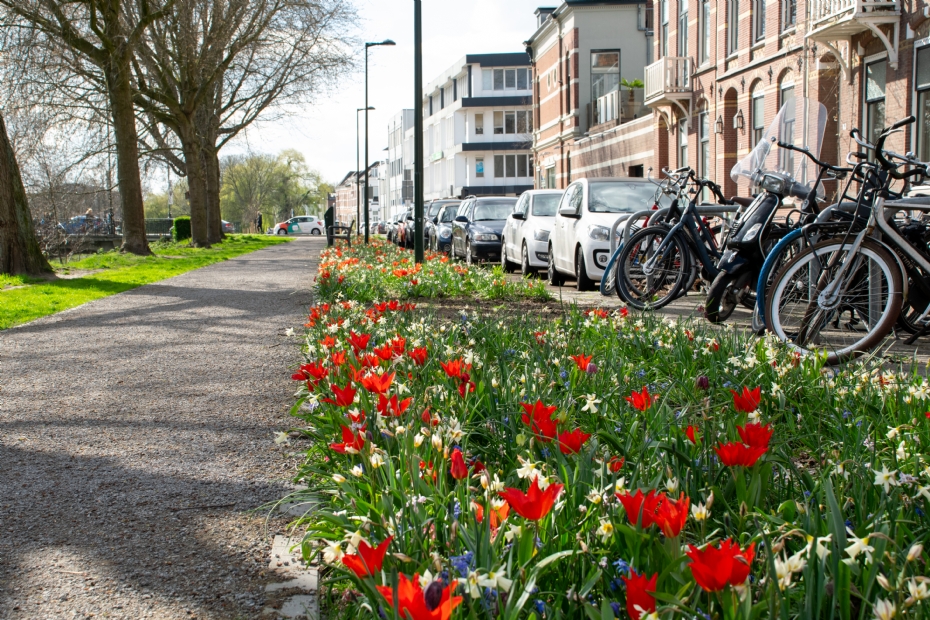A Flowering Arc of Eight Months? Yes, It's Possible! |
|
|
|
|
 |
| 149 sec |
We can create bulb mixtures that guarantee a long blooming period
JUB Holland, based in Noordwijkerhout, trades in flower bulbs and exports them—but also grows them, and how! On around 35 hectares of calcareous sandy soil, the company cultivates various types of bulbous plants, often divided into subspecies. Just tulips alone count 49 different varieties at JUB Holland.
JUB Holland was founded in 1910, and current director Robbert Uittenbogaard represents the fourth generation. "We have many years of experience with using flower bulbs in public spaces," he says. "In the past, the focus was mainly on early blooming. Bulbous plants like snowdrops, crocuses, and daffodils were seen as true heralds of spring. And they would be done blooming just in time, so roadsides, grassy strips, and parks could be mowed—everything had to look tidy. Now the approach is very different. There is more room for extensive maintenance, so in the Netherlands, we mow a lot less. That means we can now create bulb mixtures that guarantee a much longer flowering season."
Autumn Bloomers
A flowering arc with bulbs can add color and fragrance for up to five months. "And it can last even longer," says Uittenbogaard, "if we add Crocosmia and herbs to the mix. Then you can reach up to eight months of bloom, which is fantastic for biodiversity."
He gives an example of such a long-flowering mixture: "For an eight-month arc, we use—based on bloom order—snowdrops, crocuses, grape hyacinths, botanical tulips (*Tulipa turkestanica*), bluebells (*Hyacinthoides non-scripta*), and ornamental onions. In summer, Crocosmia and herbs bloom. Then in September and October, you get flowering bulbs like saffron crocus (*Crocus sativus*) and autumn crocus (*Colchicum autumnale* and the oriental hybrid *Colchicum byzantinum*)."
|
|
JUB Holland has been collaborating with the Dutch Beekeepers Association (NBV) for many years to identify which bulb species attract the most bees.
| |
|
 | | Special mixture for the Chassesingel in Breda |
|
|
Stinzen Plants
"When we create mixtures, we always first check whether we can work with native species or so-called *stinzen* plants," says Uittenbogaard. He explains: "They're resilient, they return every year, and they have the ability to self-seed. On top of that, they're highly attractive to bees and butterflies. These days there's a lot of interest in bulb-and-herb mixtures to brighten up the edges of swales. We've also noticed more and more bulbs being used in cemeteries. Bulbs can be planted almost anywhere, as long as you consider the growing conditions—soil type and surroundings. Of course, the customer's preferences are key. Sometimes they'll specify one or two particular species, but more often they choose based on color."
For the Breda ring roads, designer Carien van Boxtel—affiliated with JUB—created several different mixtures. Each avenue has its own character and therefore its own color scheme. Over the years, the entire ring around Breda's city center is being planted with these unique bulb mixes.
"When a municipality wants to enhance a space (roadside, park, square) with a flowering arc, one of our specialists visits the site. Based on soil type, maintenance, surroundings, and customer wishes, we select one of the many ready-made mixtures we've developed over the years. In special cases, we create a custom mix. Using the Flower Designer App, we then generate a visualisation of the project—giving the customer a good impression of the final result. Sometimes residents also have a say and can choose between different examples."
 | | Robbert Uittenbogaard, director at JUB Holland |
|
|
More Than Just Ornamental
"Most people only see ornamental value in bulbous plants," says Uittenbogaard, "but that's just one aspect. Flowers—including bulbs—are vital for biodiversity. They provide food for pollinators, and in turn, pollinators are essential for the production of many of the fruits and vegetables we eat."
JUB Holland has long worked with the Dutch Beekeepers Association (NBV) to determine which bulb varieties are most attractive to bees. Research by scientists at Naturalis Biodiversity Center has also yielded valuable insights. The top five bulb plants that attract bees and butterflies the most, in order of bloom, are:
Snowdrop (*Galanthus nivalis*)
Grape hyacinth (*Muscari latifolium*)
Woodland crocus (*Crocus tommasinianus*)
Wild tulip (*Tulipa sylvestris*)
Ornamental onion (*Allium*)
Uittenbogaard: "I already mentioned the ornamental value and the benefit for pollinators. But these top early bloomers—snowdrop, grape hyacinth, and crocus—have another advantage: they attract lacewings and parasitic wasps, which are natural enemies of the oak processionary caterpillar. Their larvae eat the young caterpillars. So by planting bulbs in the right places, they can be useful in more ways than one."
 | | Special mixture for Hendrik van Boeijenlaan and Prinses Irenelaan in Leidschendam and Voorburg, respectively |
|
|
This article was originally published on October 21, 2024, on the Stad + Groen website.
| LOG IN
with your email address to respond.
|
|
|
| There are no comments yet. |
|
| |
Anyone can place small ads for free through their own account.
Place a free ad
|
|
|
|